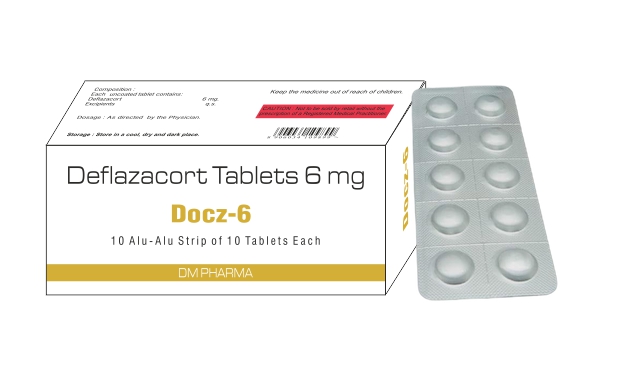Deflazacort is a prodrug. Its potency is around 70-90% that of prednisone.
Deflazacort is a synthetic steroid that has an anti-inflammatory effect.
It is used to decrease inflammation in various different diseases and conditions.
Indications and Usage:
This medication is a glucocorticoid, prescribed for anti-inflammatory conditions, and used as an immunosuppressant.
Mechanism of Action:
Deflazacort works by acting within cells to prevent the release of certain chemicals that are important in the immune system. These chemicals are normally involved in producing immune and allergic responses, resulting in inflammation. By decreasing the release of these chemicals in a particular area, inflammation is reduced. This can help control a wide number of disease states characterised by excessive inflammation. These include severe allergic reactions, inflammation of the lungs in asthma and inflammation of the joints in arthritis.
Deflazacort also decreases the numbers of white blood cells circulating in the blood. This, along with the decrease in inflammatory chemicals, can prevent the rejection of organ transplants, as it prevents the body from attacking foreign tissue. It is useful for the treatment of certain types of leukaemia, where there is an abnormally large production of certain white blood cells, and for treating certain diseases that are caused by the immune system attacking tissues in the body (autoimmune diseases). These chemicals are normally involved in producing immune and allergic responses, thus resulting in inflammation. By decreasing the release of these chemicals in a particular area, inflammation is reduced. This can help control a wide number of disease states characterized by excessive inflammation, including severe allergic reactions, inflammation of the lungs in asthma and inflammation of the joints in arthritis. Deflazacort also decreases the number of white blood cells in the bloodstream, which, along with the decrease in inflammatory chemicals, can prevent the rejection of organ transplants, as it prevents the body from attacking foreign tissue. Deflazacort is useful in the treatment of certain types of leukaemia in which there is an abnormally large production of certain white blood cells, and for treating diseases caused when the immune system attacks tissues in the body (autoimmune diseases).
Pharmacological:
A new glucocorticoid deflazacort is a D-ring substituted steroid.It is a synthetic oxazoline derivative of prednisolone, having the molecular formula11beta, 21-dihydroxy-2'-methyl-5'beta-H-pregna-1, 4-dieno [17,16d] oxazole-3, 20-dione-21-acetate.
Pharmacodynamic:
Deflazacort is a glucocorticoid. Its anti-inflammatory and immunosuppressive effects are used in treating various diseases and are comparable to other anti-inflammatory steroids. Clinical studies have indicated that the average potency ratio of deflazacort to prednisolone is 0.69-0.89 and 6 mg of deflazacort is equivalent to 5 mg of prednisolone. However, the therapeutic dosage ratio has been reported to range from 1:1.2 to 1:1.5.
Pharmacokinetic:
Orally administered deflazacort appears to be well absorbed and is immediately converted by plasma esterases to the pharmacologically active metabolite (D 21-OH), which achieves peak plasma concentrations in 1.5 to 2 h. It is 40% protein bound and has no affinity for corticosteroid binding globulin (transcortin) and binds to plasma protein and blood cells instead, crossing the blood-brain barrier in very low concentrations. These pharmacokinetic and biochemical properties of deflazacort may prevent it from reaching the hypothalamic or pituitary circulation during the first years; however, we can speculate that after a long-term treatment, deflazacort levels could increase in the central nervous system and finally produce effects similar to other glucocorticosteroids.3 Its plasma elimination half-life is 1.1 to 1.9 h. Elimination takes place primarily through the kidneys; 70% of the administered dose is excreted in the urine, and the remaining 30% is eliminated through the feces. Metabolism of D 21-OH is extensive; only 18% of urinary excretion represents D 21-OH. The metabolite of D 21-OH, deflazacort 6-beta-OH, represents one-third of the urinary elimination. Due to the short pharmacokinetic half-life of its active metabolite, pharmacodynamic effects of deflazacort are of shorter duration than those of methylprednisolone and prednisolone.
Side Effects:
Side effects can occur when taking Deflazacort. Common, but safe side effects include indigestion, menstruation cycle changes, tiredness, irritability, insomnia, and mood or behavioural changes.
More serious effects can include Cushing's syndrome (puffy face), acne, or stretch marks, and in some rare cases excessive hair growth.
If you notice any of these adverse effects while taking Deflazacort, inform your physician as soon possible.
Contraindication:
Mild or moderate typhoid due to multiple antibacterial-resistant organisms, Tuberculosis resistant to first line drugs.
Storage:
Store at room temperature away from light and moisture.
